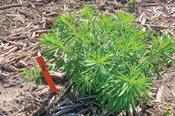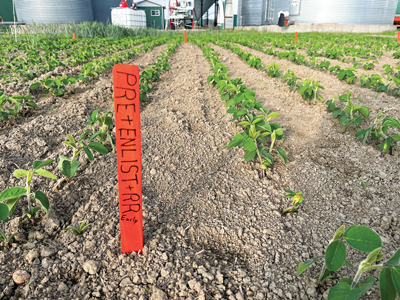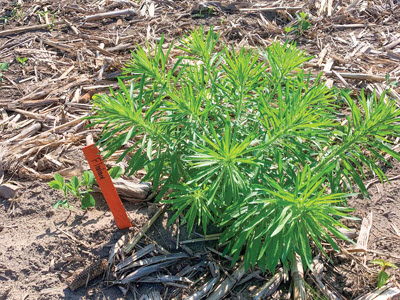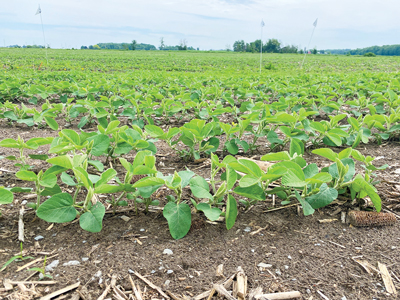
Use a multi-system approach to weed control against resistant species.
By Paul Hermans
Ask any farmer about weeds and they want them gone.
Clean fields are on the top of many growers’ minds heading into the spring planting season. Yet challenges persist in row cropping from a weed control standpoint.
Much of this is due to the continual use of glyphosate technology since the introduction of Roundup Ready soybeans in the late 1990s. With cheap, effective herbicide options, growers believed that easy weed control days were possible for many years to come.
However, Mother Nature always finds a way to overcome this.
Weed resistance and the challenges it presents exists across North America.
Newer soybean technologies have emerged like Enlist E3 (2,4-D resistant) in Ontario to help manage this resistance. If we are not careful in the stewardship of this and newer technologies coming down the research pipeline in agriculture, we will find ourselves in the same “resistance boat” down the road.
Understanding key weed control management strategies and going through some basic weed control principles will help ensure we have this technology around for years.
Weed type and weed size
Broadleaf weeds versus grasses – who wins the war?
No surprise here if we look at 20 broadleaf plants per square metre versus 20 grass plants; broadleaf weeds will cause greater yield losses than grasses. OMAFRA data would suggest, in this scenario, a 53 per cent yield loss due to broadleaf weeds versus 21 per cent for grass weeds.
The majority of hard-to-control weeds are broadleaf weeds.
Target weeds when they are young and actively growing. Once weeds get beyond four inches tall, they have more active, harder-to-control growing points.
Knowing your fields, keeping track of what weed species are present and the size of the weeds you are dealing with, and utilizing specific herbicides based on weed spectrum will help you win the war against weeds.
OMAFRA’s Ontario Crop Protection Hub website is a great starting point to select herbicide options to control specific weeds. It will list (by highest efficacy) herbicide treatments based on the weeds you enter as well as the crop specific (herbicide tolerance) and timing stage you want to pursue.
Weed timing
It is important to prioritize clean fields through the critical weed-free period. Early season weed control has shown to be a strong contributing factor to yield.
Data conducted by Dr. Peter Sikkema, Ridgetown College, would suggest we are losing about a half-bushel per day if weeds are not controlled after the VC (cotyledon) stage and as high as two bushels per day in high weed pressure situations.
Simply put, that equates to $8 to $32 per acre per day.
Keeping the crop weed-free in the cotyledon to third trifoliate stage (V3) is key.
A lot of industry chatter revolves around a program approach to weed control. It is important to have a crop protection program in place to manage the weed spectrum on your farm. Using a two-pass system, a pre-emerge residual program, followed by a post-emerge pass, is recommended to prevent resistance, manage weed escapes and reduce weed seed bank.

When talking with our crop protection counterparts across Ontario from west to east, there are fewer two-pass systems the farther east you go. Why would this be? Simply put, eastern growers have not experienced as many resistant weed species in terms of overall acres and percentage of acres affected.
But this is changing in Eastern Ontario, with Canada fleabane and, most recently, with the introduction of waterhemp in some specific geographic locales.

Recent research data from OMAFRA would suggest higher profits are obtained using a two-pass herbicide system.
In conversations with Mike Cowbrough, OMAFRA weed specialist, research conducted from 2020 to 2022 showed on average a 13 per cent yield increase in a two-pass weed control system versus a one-pass system.
This gives producers some data to help pencil out the financial value of utilizing a two-pass system in soybeans.

“Paying the piper now or paying the piper even more later,” comes to mind.
This was discussed on X-Twitter (I still like calling it Twitter) by Iowa State extension Bob Hartzler, who has posted that “the costs of herbicide programs in Iowa are increasing much more rapidly than other input costs. This will not change unless we diversify weed management.”
We must stop skimping on cheap herbicide programs, as resistance to tougher weeds will cost us more eventually.
We decided to show this principle in 2023 utilizing small demonstration plots. Across 12 distinct locations from Toronto to the Quebec border, various pre- and post-emerge treatments were applied using a C02 canister backpack sprayer. Plots were sprayed with Canopy PRO prior to planting as a pre-emerge treatment. These blocks then received a post-application treatment as well around the V2 to V3 stage. Besides the two-pass treatment, blocks were post-applied using post applications at the V2 to V3 stage. Field staff recorded visual differences to demonstrate the value of a programs approach to weed control.

Even with dry conditions approximately 75 per cent of the time, there were notable differences in weed control pressure between the two-pass and one-pass systems.
The two-pass system had uniform weed stage present when the second pass was applied, compared to the one-pass system, which had non-uniform weed stages present, making weed control easier in the two-pass system based on weed spectrum and size of weed present.
Multiple modes of action (MMOA) and different timing is vital to prevent weed resistance and ensure cleaner fields and higher yields. More importantly, making sure these are effective modes of action against the targeted weeds you are spraying is key.
Cover crops and other practices
Mechanical and cultural control methods are also effective at weed control.
Recent work in Ontario has shown that annual cereal ryegrass helps suppress Canada fleabane, a tough-to-control resistant weed.
Increased biomass from the cover crop reduces weed biomass and helps reduce emergence timing.
Tillage can be highly effective for weeds – especially perennial weeds. Knowing your weed type and density is key, though, as tillage can increase other weed species.
Crop rotation helps with weed competition and allows for different effective modes of action to be used in various crops.
White mould and soybeans
Across many geographies in 2023 white mould diseases were prevalent. Last year’s growing environment favoured this pest.
The coffee room chat about what might help with this disease going forward is top of mind for many producers this winter.
Various management practices can be utilized for this. One such practice is looking at planting soybeans in wider rows. This is counterintuitive from a weed control standpoint, as it allows for slower canopy growth and more sunlight to penetrate the canopy longer. University of Wisconsin data would suggest going from 15-inch to 30-inch soybeans delays white mould onset by 10 days due to slower canopy closure. However, delayed growth increases weed pressure – especially waterhemp – in these types of environments.
For growers wanting to maintain 15-inch row spacing while reducing white mould, population management is one avenue to explore (combined with other factors like variety selection, tillage type, crop rotation, fungicide use, planting date, and more). Reducing plant population will allow for more air movement within the canopy in high-yield/lush canopy environments.
If you are planting in 30-inch-wide rows, earlier planting dates are needed to help reduce weed pressure.

In summary, using a multi-system approach to weed control will ensure we keep resistant weed species at bay. Spraying early, when weeds are small and actively growing, is critical. Short-term planning with the use of various herbicides with different effective modes of action will win the long-term soybean yield and economic race.
Take time this winter to strategize on your weed control plans for cleaner fields and higher yields. BF



Post new comment